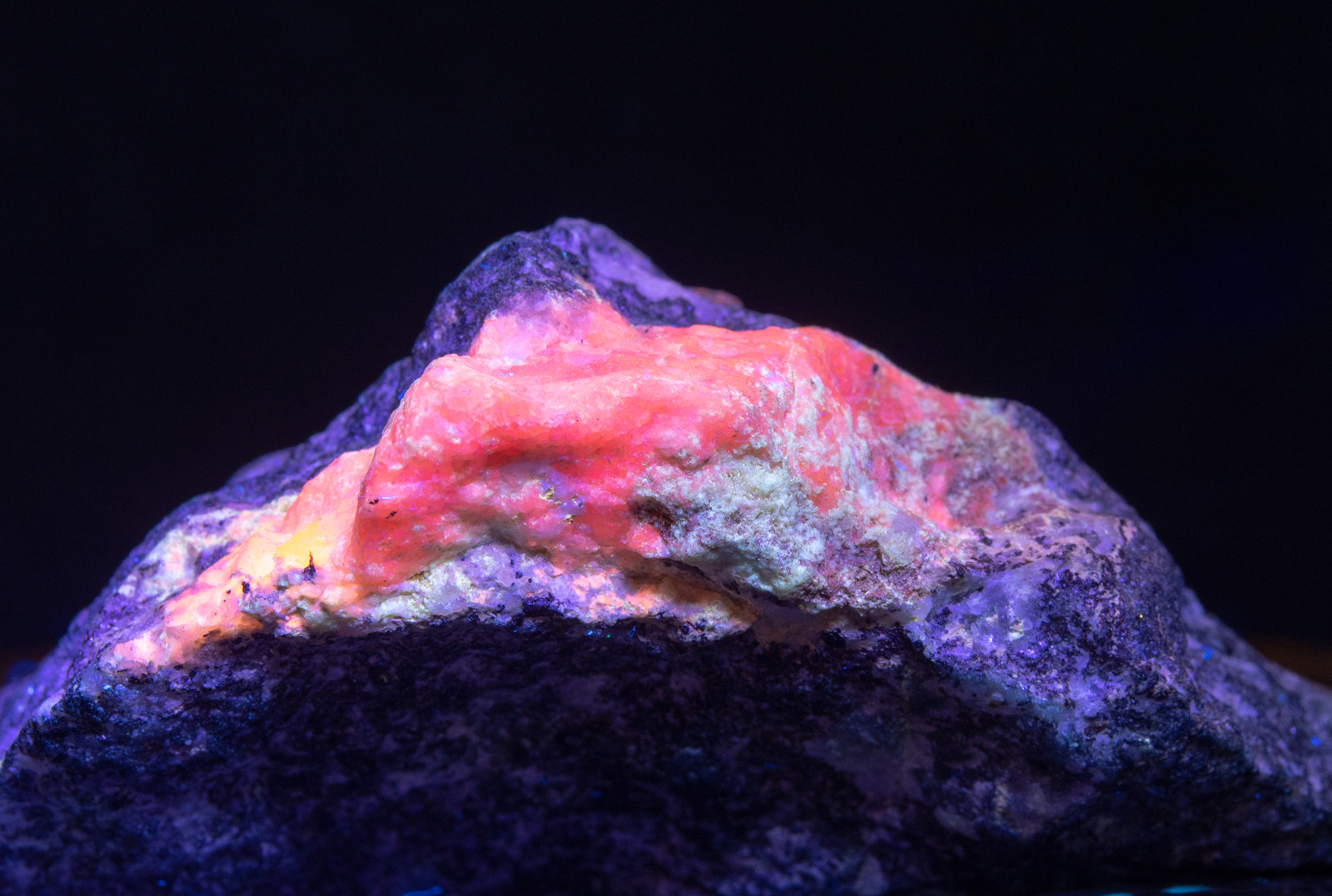
透闪石宝石:特性、含义、价值等
 杜格图普石是一种常见的斑驳宝石,主要呈红色或粉红色。它主要产于格陵兰岛,又名“驯鹿石”。
杜格图普石是一种常见的斑驳宝石,主要呈红色或粉红色。它主要产于格陵兰岛,又名“驯鹿石”。
透辉石稀有吗?是的。它是一种相当稀有的矿物,也是极其罕见的刻面宝石。它在收藏家中更为知名。
话虽如此,但滑石粉具有压电性、荧光性和暗化性等令人着迷的特性——我们将在本指南中对这些特性进行详细介绍。
跟随我们一起揭开tugtupite宝石的益处、价格、历史等背后的秘密!
 图片来源:Jessa 和 Mark Anderson, Flickr , CC-BY-SA-2.0
图片来源:Jessa 和 Mark Anderson, Flickr , CC-BY-SA-2.0
什么是图格图普石?
杜格图普石是一种最近才被发现的半宝石,自20世纪60年代才为人所知。这种稀有宝石是在格陵兰岛发现的,在那里它也被称为“图克图”(Tuktu),意为“驯鹿血”,源于格陵兰因纽特语中“驯鹿”的意思。
从占星学角度来看,图格图石对狮子座有利。
当这种宝石分别带有粉色和白色条纹或粉色和黑色条纹时,它可能类似于菱锰矿和蔷薇辉石等宝石。然而,菱锰矿是锰硅酸盐,蔷薇辉石是锰碳酸盐,而斜方辉石不含锰。
尽管它们看起来可能不同,但方钠石和斜方石的关系更为密切,并且经常一起生长。
科学家已经合成了方钠石,用于研究不同方钠石族矿物如何发光,但合成的方钠石尚未被用作宝石。
吐格图普石规格和特征
铍铝硅酸盐是一种含氯和钠的铍铝硅酸盐。该矿物的化学式为Na4AlBeSi4O12Cl。常见杂质包括铁、镓、硫、镁、钾、钙和水。
该矿物可归类为似长石矿物组,该组矿物属于网状硅酸盐,与长石类似,但二氧化硅含量较低,结构也不同。其他似长石矿物包括阿富汗石、透锂长石和方钠石组矿物。
更具体地说,斜方硅镁石是方钠石矿物组的一部分,有时被认为是方钠石的一个亚组。
吐格图普石的晶体形态包括短棱柱体(含楔形体,四面体,封闭型)或金字塔形、块体和细粒集合体。晶体可能呈现穿透孪晶,形成伪立方三重晶,或伪三角接触孪晶。
 上图:暴露于 UVabc 光后呈现磷光状态的 Tugtupite 和 chkalovite 标本 | 图片来源:Cran Cowan, Flickr , CC-BY-SA-2.0
上图:暴露于 UVabc 光后呈现磷光状态的 Tugtupite 和 chkalovite 标本 | 图片来源:Cran Cowan, Flickr , CC-BY-SA-2.0
透格图普石的光学性质
如前所述,透辉石具有一些令人惊叹的特性。
首先,它能发出强烈的荧光(在X射线或紫外线下发光)和磷光(发光时间较长,类似“夜光材料”)。有人甚至称它为“荧光矿物之王”。
但最令人印象深刻的是钙钛矿的暗化现象,或“可逆光致变色现象”。
变色现象是宝石中最罕见的光学现象,指的是宝石在暴露于某些光线(通常是紫外线,例如阳光)后会变色,之后又会恢复到原来的颜色。这种变化可以反复发生,但不会永久影响宝石的颜色。
与变色宝石不同,暗色宝石在不同光线照射下会逐渐改变颜色。
因此,温暖和紫外线照射(如阳光)会使透辉石的颜色更加浓郁,通常从浅粉色变为鲜红色。
其他可呈现暗辉光的宝石仅有方钠石(罕见)、锂辉石和方钠石种类的黑方钠石。
以下列出了 tugtupite 的所有属性:
莫氏硬度:4-6.5
颜色:通常为白色、粉色、玫瑰红色、深红色、绿色;很少有蓝色;常见斑点
晶体结构:四方
光泽:玻璃光泽、亚玻璃光泽、蜡状光泽、暗光泽或油腻光泽
透明度:半透明至不透明
折射率:1.496-1.502
密度:2.11-2.60
乳沟:{101} 清晰/良好;{110} 一般
断口:不规则/不均匀或贝壳状
条痕:白色
发光:存在荧光 - 在短波紫外线下呈现明显的玫瑰红色,比在长波紫外线下更强,或在短波紫外线下呈现橙红色,在长波紫外线下呈现橙色;存在磷光 - 从亮乳白色到橙乳白色,或从暗红色到乳白色;X 射线 - 使较浅的颜色变暗
多色性:存在,从弱到强 - 蓝红色到橙红色或淡紫色到红橙色
双折射率:0.006-0.008;异常双轴
分散度:0.012
光学现象:暗化
那么,图格图普石的形而上学属性和意义又如何呢?
 图片来源:Parent Géry, CC-BY-SA-3.0
图片来源:Parent Géry, CC-BY-SA-3.0
图格图普特的含义和历史
吐格图普石象征着乐观、和谐与爱。有些人认为吐格图普石的精神意义在于点燃你曾经失去或遗忘的激情或爱。
这种宝石在阳光下会变得更鲜艳,但在黑暗中则会褪色,可以提醒你让内心的光芒闪耀。
在格陵兰,图格图石激发了许多传说,其中最著名的是图图的故事:
因纽特人的传说中,图图,也就是“驯鹿女孩”,爬上高山,生下了她的第一个孩子。分娩过程中,流出的血液渗入山石,形成了图图特石。
历史
1957 年,丹麦矿物学家亨宁·索伦森 (Henning Sørensen) 在格陵兰岛的图格图普阿格塔科菲亚首次发现了图格图普石。这种矿物是在一个名为伊利毛萨克杂岩的地区发现的,1811 年欧洲探险家在同一地区首次发现了方钠石。除了方钠石之外,这里也是许多其他矿物的典型产地,包括方钠石和异方钠石。
“图格图普石”这个名字就源于最初的产地,而“图格图普”在格陵兰因纽特语中是“驯鹿”的意思,因此它被称为“驯鹿石”。这块石头的红色,类似于著名的驯鹿鲁道夫的红鼻子,也可能是这个绰号的由来。
然而,这种石头最初的名字是铍方钠石。俄罗斯矿物学家叶夫根尼·伊万诺维奇·谢苗诺夫和亚历山德拉·瓦西里耶夫娜·比科娃于1960年发表了他们在俄罗斯发现铍方钠石的消息。直到1962年在格陵兰岛的另一个地区发现这种石头后,人们才对它产生了更广泛的兴趣。
索伦森于 1963 年提出了“tugtupite”这个名称,该名称于 1965 年获得国际矿物学协会 (IMA) 的认可。第一颗 tugtupite 宝石也于 1965 年问世。
与努米石一样,图格图石的唯一宝石产地是格陵兰岛。不幸的是,自首次发现以来,这种宝石已变得极其稀有。
回到形而上学方面,透辉石晶体具有什么治疗特性?
透格图普石的治疗功效
作为一种主要为粉红色的治疗石,粉彩石与其他粉红色宝石一起带来接纳和爱,同时也是心轮石。
吐格图石对您的身体有何作用?
身体康复
从物理角度来看,据说透辉石晶体有助于:
荷尔蒙平衡
不孕不育
血液循环
心脏健康
情绪疗愈
从情感上来说,图格图石能帮助那些正在应对愤世嫉俗或消极情绪的人,尤其是那些源于过去苦难或背叛的人。人们相信,这种水晶能帮助你在心碎之后敞开心扉去爱,并帮助你重新爱自己。
上图:长波紫外线下的吐格图普石 | 图片来源:Géry PARENT, CC-BY-SA-3.0
吐格图普石宝石特性
除了稀有性之外,透辉石宝石的价值还取决于颜色、切工、净度、透明度和克拉重量。
颜色
吐珠矿宝石中常见的粉红色是由含硫色心造成的。吐珠矿通常呈斑驳状,其他颜色包括黑色、白色,有时还有绿色。蓝色吐珠矿较为罕见,目前可能只有不到十颗蓝色吐珠矿凸圆形宝石被切割。
红色和粉红色的宝石比白色或黑色的宝石通常更有价值。
在收藏家当中,强多色性、暗色性和发光性也很重要。
切
最常见的是,吐珠石被切割成凸圆形宝石、雕刻品,或未经切割(原石)出售。 刻面吐珠石宝石极其稀有且珍贵。
清晰度和透明度
净度是指宝石中可见内含物的程度,内含物会降低宝石的透明度和价值。透辉石通常含有内含物,通常带有黄色斑点或黑色针状物。内含物越少,透明度越高,价值也就越高。
克拉重量和尺寸
刻面的吐珠石数量极少,且均较小(1-2克拉),且并非完全无内含物。大多数半透明的吐珠石会变成凸圆形,较大的样本通常会被切割(或出售原石)用于装饰。
 上图:长波紫外线下的吐格图石标本 | 图片来源:Géry PARENT, CC-BY-SA-4.0
上图:长波紫外线下的吐格图石标本 | 图片来源:Géry PARENT, CC-BY-SA-4.0
吐格图普岩的形成和来源
吐格图普石形成于侵入火成岩(主要为霞石正长伟晶岩)内的热液脉中。方钠石族矿物通常在火成岩形成时从其内部富含钠的岩浆中结晶而来。
铍钠硅酸盐奇卡洛夫石也可以通过取代钠铍硅酸盐奇卡洛夫石而形成。
与透辉石一起发现的相关矿物包括:
采矿地点
几乎所有宝石级的吐格图石都产自格陵兰岛的塔塞克(Taseq)和克瓦内菲尔德(Kvanefield)地区。此外,已知的产地仅有加拿大和俄罗斯。
吐格图石的稀有性部分源于其在格陵兰岛的开采难度。矿工必须乘船或步行前往高山,将矿石装在袋子里运回。
 上图:紫外光照射下的图格图普石吊坠(镶嵌于 18K 金中)| 图片来源:Jessa and Mark Anderson, Flickr , CC-BY-SA-2.0
上图:紫外光照射下的图格图普石吊坠(镶嵌于 18K 金中)| 图片来源:Jessa and Mark Anderson, Flickr , CC-BY-SA-2.0
Tugtupite 价格和价值
由于这种宝石如此稀有,因此在浏览待售的图格图石时,您可以预期其价格相当高 - 尽管仍然低于许多珍贵宝石。
虽然一些质量较低的刻面斜长石的价格约为每克拉 30 至 40 美元,但大多数价格约为每克拉 270 至 480 美元或更高。
透辉石凸圆形宝石的价格约为每克拉 8 至 240 美元,但大多数价格约为每克拉 20 美元。
粉红色的吐珠石凸圆形吊坠售价约为 100 至 2,200 美元,而原石吊坠的价格通常为 30 至 100 美元。吐珠石戒指的价格通常为 200 至 500 美元。耳环的价格约为 200 至 250 美元。
最后,我们将讨论透辉石宝石的护理。
塔格图普石的保养和维护
由于其莫氏硬度低且解理清晰,吐珠石首饰可能易碎。我们建议选择吊坠和耳环——最好只佩戴带有保护性镶嵌的吐珠石戒指。
用温和的肥皂、温水和软毛牙刷清洁图格图石。请勿使用机械清洁设备。请将其与其他宝石分开存放,以免刮伤。
 上图:紫外光下的吐格图普石和奇卡洛夫石样本 | 图片来源:Cran Cowan, Flickr , CC-BY-SA-2.0
上图:紫外光下的吐格图普石和奇卡洛夫石样本 | 图片来源:Cran Cowan, Flickr , CC-BY-SA-2.0
Tugtupite 是否触动了你的心弦?
宝石收藏家们钟爱苏格图石,因为它拥有美丽的色彩和紫外线反应;而水晶治疗师则因其能够为生活带来纯洁爱情的魔力而推崇苏格图石。无论您持何种观点,苏格图石都拥有诸多值得您喜爱之处!
搜索Gemstone Encyclopedia
最新的文章
彩虹格纹日光石是一种长石,由于内部含有各种包裹体,呈现出三种绚丽的光学效应。它绚丽多彩的光泽和格纹图案使其成为收藏家梦寐以求的珍宝!
12th Jan 2026
文章分类
How To's is where you will find helpful articles from gem Rock Auctions on how to cut gemstones, select gemstones and buy gemstones.
9文章数
